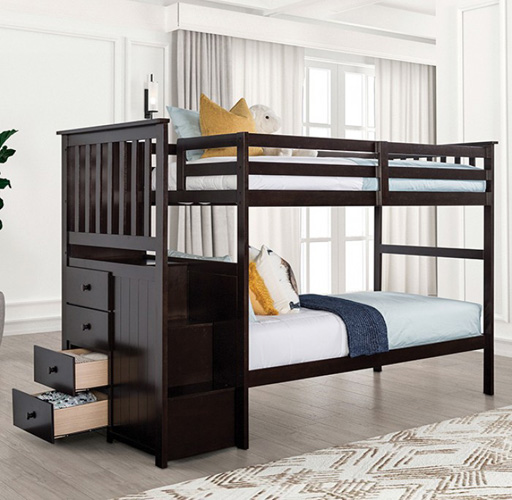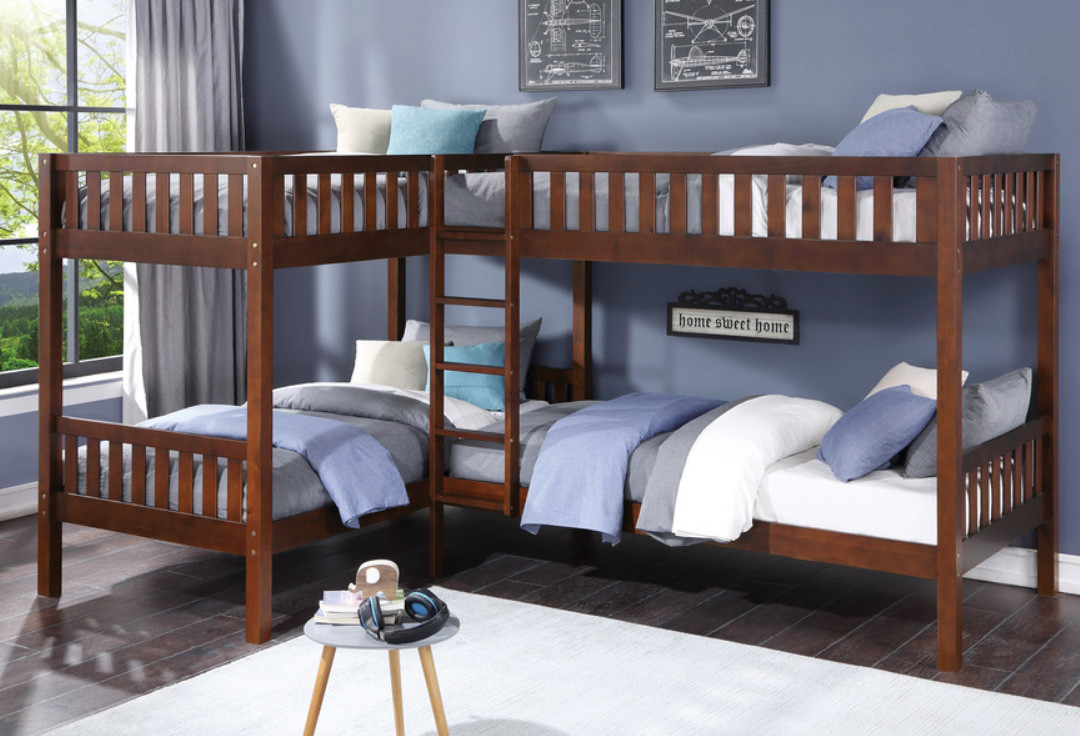How Twin Bunk Beds Can Help Siblings Bond and Share - JustBunkBeds
Posted by UPW on Jul 17th 2024
The bond between siblings is profoundly shaped by their shared experiences, especially during their formative years. Twin bunk beds serve not just as a practical sleeping solution but as a vital element in strengthening these relationships.
As children grow together in a shared space, the right bunk bed can transform their room into a haven of companionship and mutual support. With numerous designs, including twin wood bunk beds and twin metal bunk beds, how can parents choose the right style that enriches their children's interactions and supports their relationship?
The Role of Bunk Beds in Establishing Daily Routines
Establishing daily routines is crucial for children's development, offering structure and stability that benefit their overall growth. Twin bunk beds play a significant role in this process by providing a designated personal space that supports regular habits and time management. These beds help delineate clear boundaries and responsibilities, reinforcing routine and discipline, crucial for fostering healthy habits from a young age.
●Defined Sleep Schedules: Twin bunk beds help siblings adhere to consistent sleep schedules. Each child knows their specific bed, simplifying bedtime and wake-up routines, which is essential for developing a healthy sleep pattern.
●Organized Living Space: The structured setup of bunk beds encourages children to keep their areas tidy. This organization extends to daily habits, where children learn to manage their belongings and maintain a clean environment.
●Routine Building Features: Many twin bunk beds come with features like attached bookshelves. These elements support nightly reading habits and morning preparations, integrating learning and personal care into daily routines.
●Collaborative and Individual Activities: The arrangement of twin bunk beds often encourages both joint and solo activities. Siblings can engage in shared playtime or quiet individual tasks such as drawing or reading, balancing interaction and independence.
By embedding structured practices into everyday life, twin bunk beds do more than furnish a room—they help cultivate a disciplined lifestyle for siblings, teaching them the importance of routine and personal space management. For families seeking to instill good habits and cohesiveness in their children’s daily lives, twin bunk beds offer both a practical and strategic solution
Design Features That Promote Sharing
The architectural design of twin bunk beds plays a pivotal role in balancing shared experiences with personal independence, making them perfect for siblings. These beds are crafted to maximize interaction through shared environments that encourage communication and play, yet they respect individual space needs. The Kingston House Twin Bunk Bed exemplifies this with its distinct, house-inspired twin-over-twin setup, where each child has their own designated area complemented by common spaces that invite sharing and collective activities.
As needs evolve with age and children require more individualized spaces, twin loft bunk beds become a superb choice. For instance, the Aiden Black Twin Workstation Futon Loft Bed caters to the growing demand for personal study and leisure areas.
It combines a sleeping area with an extensive L-shaped desk and a comfortable futon, all within a design that safeguards privacy while promoting a shared environment. This bed is particularly suited to older children, offering a sophisticated yet practical space that nurtures both academic pursuits and relaxation in a communal setting.
Safety Features for Peace of Mind
Ensuring the safety of bunk beds is a critical concern for parents, especially when these beds are meant for children of different ages sharing a room. Bunk bed designs now integrate advanced safety features that safeguard against common risks, providing a secure sleeping environment. These features are meticulously designed to meet strict safety standards, ensuring that every bunk bed offers not only comfort but also peace of mind for parents. Below, we explore the specific safety elements that make bunk beds a reliable choice for family homes:
●Guardrails on All Sides: Every bunk bed is equipped with high guardrails that prevent falls, especially from the top bunk. These barriers are designed to be tall enough to provide safety, even with a thick mattress.
●Sturdy, Integrated Ladders: Safe access to the upper bunk is provided by solidly constructed ladders. These ladders are often built into the frame to enhance stability and prevent tipping.
●Adjustable Guardrails: Some models feature guardrails that can be adjusted or removed as children grow older and their needs change, maintaining safety throughout their use.
●Low Height Design: Low-profile bunk beds are available for younger children. These beds sit closer to the ground, reducing the risk of injury from falls.
●Built-In Staircases: For added safety, many bunk beds come with staircases instead of ladders. These stairs provide easier access for younger children and often include built-in drawers for additional storage.
The safety features embedded in modern bunk beds address parents' primary concerns and cater to growing children's needs. Ensuring robust safety standards, bunk beds are an excellent choice for parents looking to combine functionality with peace of mind
The Psychological Benefits of Shared Sleeping Spaces
Sharing a room with siblings is a formative experience that shapes both emotional and psychological development in children. By fostering a shared environment through the design and arrangement of twin bunk beds, siblings gain the opportunity to develop stronger interpersonal connections, experience heightened emotional security, and enjoy the benefits of cohabitation.
These interactions are pivotal in creating a nurturing space that aids in their overall growth. Let's delve into how twin bunk beds effectively support these psychological and emotional advantages:
●Enhanced Emotional Bond: The proximity provided by twin bunk beds enables siblings to engage in nightly conversations and share experiences, strengthening their emotional connection. This close quarters interaction is crucial for developing deep familial bonds.
●Security and Comfort: Having a sibling close by during the night can significantly reduce fears such as the dark, making the bedroom a safe haven and providing a sense of security that can lead to more restful sleep.
●Encouraging Responsibility: Sharing a room helps siblings learn to negotiate space and responsibilities, such as organizing their shared storage areas and maintaining their individual spaces within the bunk bed setup.
●Promoting Conflict Resolution: Regular interaction in a shared space naturally leads to conflicts, but it also compels siblings to develop conflict resolution skills, which are beneficial in all areas of life.
●Adaptable for Various Ages: Twin bunk beds can be particularly effective for both younger and older children by offering configurations that accommodate their growing needs while maintaining the comfort of shared living.
Through these features, twin bunk beds do more than save space—they enhance the lives of those who use them, facilitating a nurturing environment where siblings can grow closer both during the day and through the quiet hours of the night.
Choosing the Right Twin Bunk Bed
From enhancing daily routines to providing a secure environment, twin bunk beds are essential for fostering healthy sibling relationships. They support not just the physical safety of your children but also their emotional and psychological growth. Explore our extensive range at Just Bunk Beds to find a bed that not only meets your practical requirements but also enriches your children’s shared experiences.





